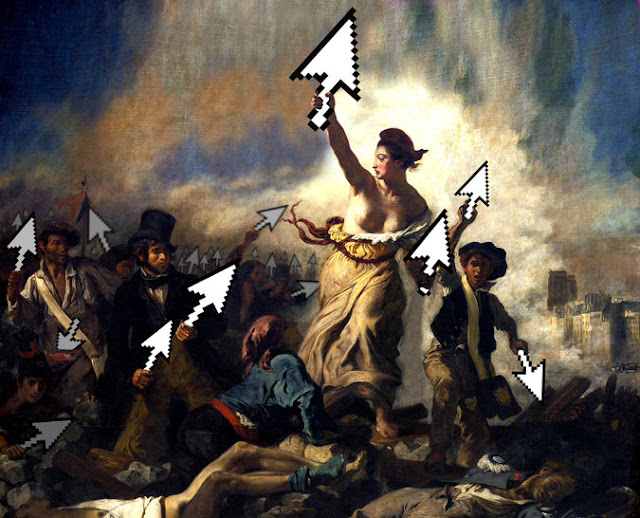From Guerrilla Aesthetics to Digital Dissent: The Art That Won’t Stay Silent
Imagine a world where the evening news isn’t controlled by media conglomerates, where advertising spaces are hijacked with messages of resistance, and where digital platforms become battlegrounds for truth. This is the world of Tactical Media Art, where artists act as cultural saboteurs, hacking the system to expose corruption, question authority, and empower the public.
From Banksy’s subversive street interventions to The Yes Men’s viral corporate hoaxes, Tactical Media artists blend art, activism, and technology to infiltrate mainstream narratives. Their work isn’t just about making a statement, it’s about making an impact.
What is Tactical Media?
Tactical Media isn’t confined to galleries or museums. It thrives in the streets, online, in fake press releases, pirated broadcasts, and hacked billboards. It’s a form of artistic resistance, a way of weaponizing media against dominant power structures.
Coined in the 1990s by media theorists David Garcia and Geert Lovink, the term describes artists who use available media tools, video, the internet, radio, television, and performance, to disrupt mainstream discourse. Tactical Media isn’t passive. It’s an intervention. It forces us to confront the realities that institutions try to hide.
From Dada to Digital Warfare: The Roots of Tactical Media
While Tactical Media as a concept is modern, its DNA is deeply rooted in avant-garde and activist art:
- The Situationists (1950s-1970s): Figures like Guy Debord disrupted consumer culture through détournement (media hijacking).
- Feminist Media Art (1970s-1980s): Artists like Barbara Kruger and Jenny Holzer took advertising aesthetics and repurposed them for political messaging.
- Culture Jamming (1980s-1990s): Groups like Adbusters and artists like Shepard Fairey (creator of the Obey and Hope posters) used street art and subvertising to fight corporate influence.
Key Artists and Collectives in Tactical Media
Banksy: The Elusive Master of Street Intervention
No list of Tactical Media artists is complete without Banksy. His politically charged street art, from murals critiquing war to dystopian amusement parks like Dismaland, exposes power structures in the most public and unauthorized spaces. His 2018 self-shredding artwork, which destroyed itself right after being sold at auction, was a perfect tactical media stunt: a direct critique of the commercialization of art.
The Yes Men: Corporate Hoaxes and Political Disruption
What if you saw a news report announcing that ExxonMobil would take full responsibility for climate change? Or that McDonald's was switching to fair trade practices? The Yes Men, a duo of media pranksters, create fake corporate announcements that expose hypocrisy. Their most famous stunt? Disguising themselves as Dow Chemical spokespeople and falsely promising compensation for victims of the Bhopal disaster, forcing real corporate executives to scramble and reveal their inaction.
Ai Weiwei: Tactical Media as Global Resistance
Chinese dissident artist Ai Weiwei embodies Tactical Media in the digital age. From his viral middle finger photos aimed at global landmarks (Study of Perspective) to his installations exposing government failures, he leverages photography, sculpture, and social media to challenge authoritarianism. His Twitter activism and surveillance-based installations highlight the power of art in fighting censorship.
Barbara Kruger: The Art of Media Hijacking
With her bold text-on-image aesthetic, Barbara Kruger was a Tactical Media artist before the term even existed. Using the language of advertising, she turns marketing slogans into radical feminist and anti-capitalist statements. Think of her famous work: Your Body is a Battleground, it could be a real ad, but instead, it’s an act of political resistance.
Critical Art Ensemble: When Art Becomes Hacktivism
This radical collective of artists, programmers, and researchers hacks biological, digital, and military infrastructures to reveal their hidden control mechanisms. Their projects range from performances that expose government surveillance to DIY bio-art labs that challenge corporate science. In the post-9/11 world, their work has even led to FBI investigations, proving that Tactical Media isn’t just theoretical, it’s dangerous.
The Tactics of Tactical Media: How Art Fights Back
Tactical Media operates on agility, surprise, and subversion. Here are some common techniques:
- Culture Jamming: Hijacking corporate symbols and ads for social critique (e.g., Banksy’s reimagined billboards).
- Fake News & Hoaxes: Spreading disinformation to expose deeper truths (e.g., The Yes Men’s fake press releases).
- Digital Activism: Using online platforms to disrupt political narratives (e.g., Ai Weiwei’s viral campaigns).
- Street Interventions: Public art installations that disrupt daily life (e.g., Guerrilla projections on buildings).
Why Tactical Media Still Matters Today
In an age of disinformation, AI-generated propaganda, and media monopolies, Tactical Media is more relevant than ever. Artists are adapting to deepfake technology, blockchain art, and encrypted activism to keep up with evolving systems of control.
The future of Tactical Media might include:
- Augmented Reality (AR) activism that overlays protest messages on cityscapes.
- AI-generated artworks that challenge biased algorithms.
- Blockchain-based counter-surveillance tools that decentralize media power.
Final Thoughts: Can Art Really Change the System?
Tactical Media isn’t just about making noise, it’s about making the invisible visible. Whether through subversive graffiti, viral hoaxes, or digital hacks, these artists challenge us to question what we’re told, who controls information, and how art can reclaim public space.
The next time you see an unsettling billboard, a hacked ad, or a viral media stunt, ask yourself: Is this art? Or is it a revolution in disguise?




.jpg)







No comments:
Post a Comment